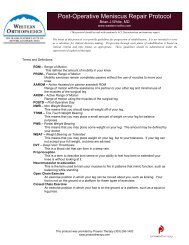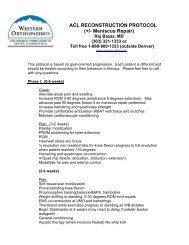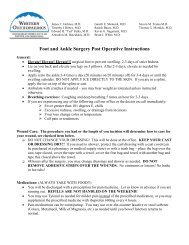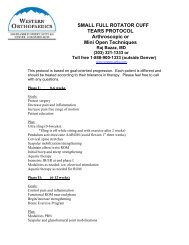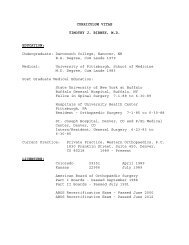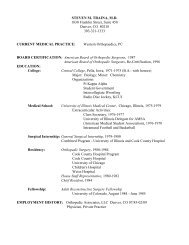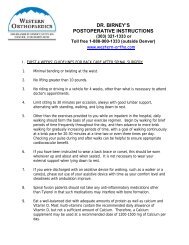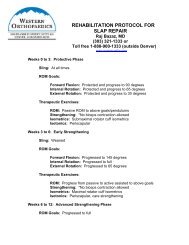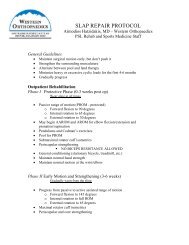Anterior Hip
Anterior Hip
Anterior Hip
- No tags were found...
You also want an ePaper? Increase the reach of your titles
YUMPU automatically turns print PDFs into web optimized ePapers that Google loves.
Tips for After DischargeSwelling/BruisingDue to the nature of joint replacement surgery,swelling of part or all of your surgical extremity iscommon because of the normal inflammatoryresponse the body has to the surgery. Most totaljoint patients can expect some amount of bruisingin their surgical extremity and the bruising tends toget worse a few days out from surgery. Somepatients have a lot of swelling and bruising whileothers may have just a little because everyoneresponds differently to the surgery. Both swellingand bruising can travel up and down yourextremity after surgery because of the effect ofgravity. For example, the more you stand up andwalk, the more gravity will pull the bruising andswelling down your leg. When you elevate yourleg, the reverse effect will happen.StiffnessJoint stiffness is also very common with jointreplacements. The joint stiffness will be worsewhen you have been sitting for a prolonged periodof time and when you first get out of bed in themorning. The stiffness improves with movement ofthe joint so avoiding sitting for prolonged periodsof time within the first few weeks after surgerymay be helpful. Some patients will continue to havesome stiffness in their joint for several months aftersurgery.IceIce is a very effective pain reliever so your surgeonmay order a cold therapy unit for you to use aftersurgery. If not, bags of ice or reusable ice packswork just as well to provide pain relief. Please makesure to protect the skin with a washcloth or pieceof clothing because ice directly on the skin cancause frostbite. You should avoid icing right beforeyou do your exercises because it can tighten thetissues you are trying to stretch out. If using bags ofice or ice packs, icing for twenty minutes at a timeis usually adequate. Cold therapy units can be lefton longer because they do not get as cold. Makesure that the hose on the cold therapy unit doesnot sit directly on your skin because frostbite mayoccur.ElevationThe swelling associated with joint replacementsurgery can cause significant pain or discomfortand the most effective way to reduce swelling is byelevating your surgical extremity above your heart.Placing your leg on an ottoman while sitting in achair will not be very effective in reducing yourswelling. The best way to elevate is to lay flat onthe couch or in your bed and place your surgicalextremity on several pillows so that gravity canhelp pull the fluid out of your extremity.ShowerThe majority of total joint patients will have theirfirst shower in the hospital with an occupationaltherapist one to two days after surgery. Mostincisions can get wet in the shower after you aredischarged home from the hospital. In some cases,your surgeon may want your incision to stay dryfor a few days so you should keep your dressingsdry with a plastic bag while in the shower. Look toyour discharge instructions for any specificdirections for showering. You should avoid soakingyour incision in water, like a bathtub or swimmingpool, until your surgeon tells you the incision hashealed well enough.



